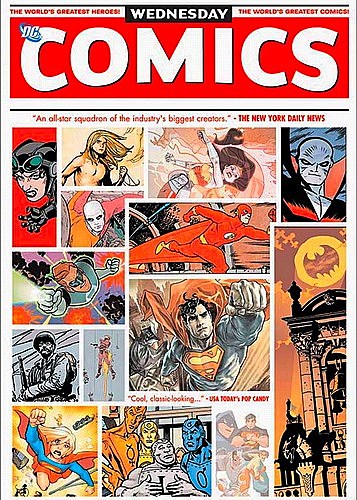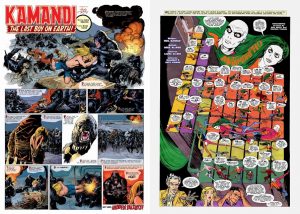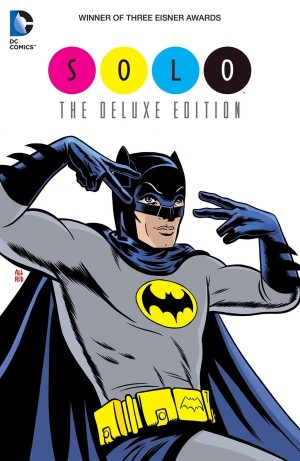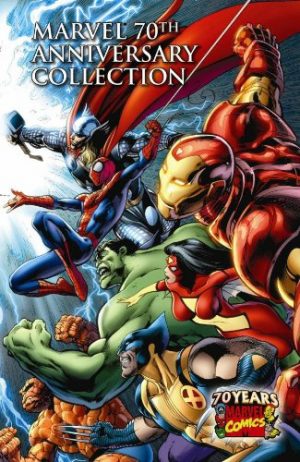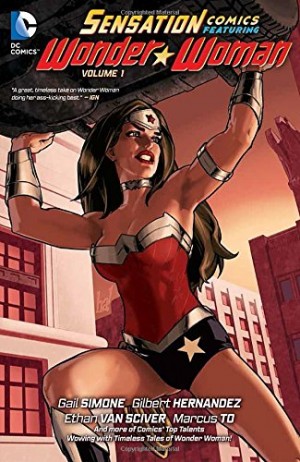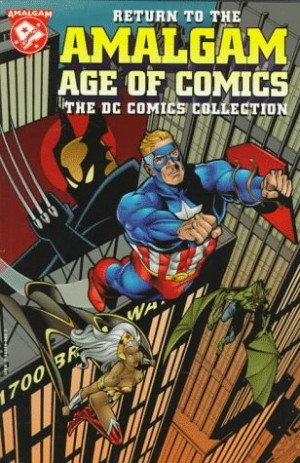Review by Frank Plowright
As originally published, Wednesday Comics was nifty idea. For twelve weeks DC issued the equivalent of an old fashioned Sunday newspaper supplement at broadsheet size (once unfolded) featuring a single page of fifteen serialised strips by fifteen different creative teams.
With each page four times the size of the standard printed comic page (although slightly reduced for this hardcover edition) there was an opportunity for some spectacular art, and it’s surprising that so few artists took advantage. Some occasionally drop in a large panel, some build up to a single magnificent page in twelve, but most content is delivered as standard comics. It’s the team of Neil Gaiman and Michael Allred whose Metamorpho story is by some distance the most imaginative use of an oversized page. Paul Pope also seizes the moment, structuring his Adam Strange story to infuse John Carter style fantasy with a pulp mood, and Sean Galloway also shows some ambition, but on Eddie Berganza’s lacklustre Teen Titans script rotating the narrative around the team. Karl Kerschl and Brenden Fletcher use the format by splitting their pages into two strips. One half is the Flash attempting to solve an ever more complex problem while the other is first the reactions of his wife Iris West to what’s happening, then the rise of Gorilla Grodd. It’s clever, additionally so in its use of super speed tricks, but takes some keeping up with as ever more Flashes manifest.
Dave Bullock’s Deadman makes good use of the page size for imposing imagery, but Vinton Hueck’s script puzzles by sidelining Deadman’s primary ability to possess the bodies of others, instead casting him as an athlete in hell. It’s a missed opportunity. Ben Caldwell’s approach is interesting, but off-putting. Instead of using the page size to present spectacle, he takes the opposite route, telling his Wonder Woman story in dozens of very small panels, anything up to sixty cramped illustrations on a page. His plot of a young Wonder Woman having to gather the seven stars of the Amazons has its moments, but it’s hard work. The Kamandi strip most resembles the likes of Prince Valiant, with Ryan Sook’s lush art accompanying a script from Dave Gibbons told entirely in captions. It’s a summary of Jack Kirby’s themes for the original series, and looks amazing.
Elsewhere the work of superior artists such as Amanda Conner and José Luis García-López, Joe Kubert and Brian Stelfreeze looks as good as ever, but could have been for standard size comics, Kubert sticking almost exclusively to a nine panel grid. Stelfreeze works on Walt Simonson’s teaming of Catwoman and the Demon, one of the oddest strips here, although nowhere near as bonkers as Kyle Baker’s Hawkman, which features an alien invasion, Dinosaur Island and Aquaman, who Jimmy Palmiotti also includes in the funny Supergirl feature.
On Batman Brian Azzarello and Eduardo Rizzo supply the taut, dark thriller that might be expected, and Kurt Busiek and Joe Quinones aren’t stretched on Green Lantern. Lee Bermejo’s Superman looks excellent, but John Arcudi providing a script in half a dozen large panels per page to show him at his best sacrifices the story.
With the original purpose not as relevant for a graphic novel, the reading experience is changed as entire stories are presented sequentially, not a page at a time. Fair enough, but it does mean you’re stuck with a dozen pages at a time of the poorer writing. The art compensates. Styles are varied, but there’s not a bad page here, and the oversize presentation is great.
